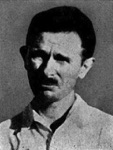Copyright © 1986-2016, Witness Collection and other copyright holders. All rights reserved.
Images and content on this site may not be reproduced in any form without prior written consent from Witness Collection.
For information about exhibitions, loans, internships or other forms of collaboration, please email us via the contact us page.

In 1925, Inguimberty moved to Hanoi, having been hired by Victor Tardieu to become head of the painting department at the newly established École des Beaux-Arts de l’Indochine. Inguimberty was noted for encouraging his students to paint in the countryside and focus on the effects of light and colour. He remained in charge of the painting department until 1945, when the college closed due to the overthrow of the French administration by the occupying Japanese forces. Inguimberty departed Vietnam in November 1946. Possibly his greatest legacy to Vietnamese art was that of encouraging his students to experiment with lacquer as a fine art painting medium; lacquer painting has become Vietnam’s greatest contribution to world art. Inguimberty died in Menton in the South of France on 8 October 1971.
Joseph Inguimberty
Joseph Inguimberty was born in the French Mediterranean port city of Marseille on 18 January 1896. From an early age he loved drawing. He entered art school in 1910 and also followed courses in architecture. In 1913, Inguimberty was admitted to the Ecole Nationale Superieure des Arts-Decoratifs (National School of Decorative Arts) in Paris for further studies under Eugene Morand. His studies were interrupted when he was drafted into the military during World War I. After the war he returned to art school and won a travel scholarship in 1920, which took him to the Netherlands and Belgium. He won the Blumenthal Prize in 1922 and the National Prize for painting in 1924.
In 1925, Inguimberty moved to Hanoi, having been hired by Victor Tardieu to become head of the painting department at the newly established Fine Arts College of Indochina (Indochina Fine Arts School). Inguimberty was noted for encouraging his students to paint in the countryside and focus on the effects of light and colour. He remained in charge of the painting department until 1945, when the college closed due to the overthrow of the French administration by the occupying Japanese forces. Inguimberty departed Vietnam in November 1946. Possibly his greatest legacy to Vietnamese art was that of encouraging his students to experiment with lacquer as a fine art painting medium; lacquer painting has become Vietnam’s greatest contribution to world art. Inguimberty died in Menton in the South of France on 8 October 1971.
